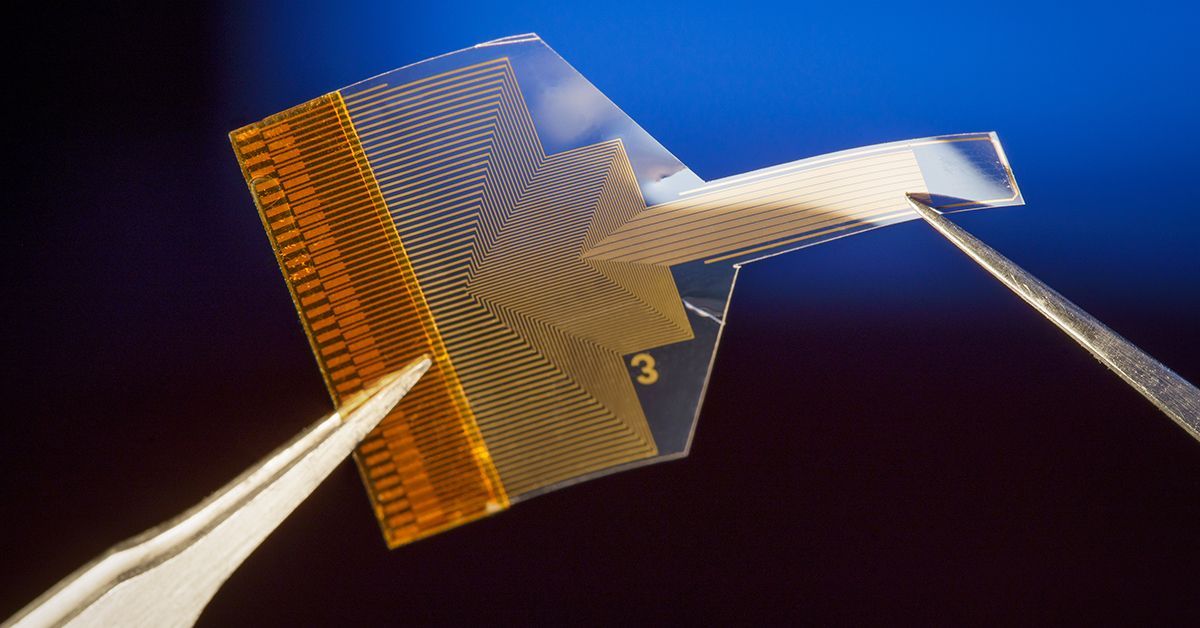A neural implant developed by researchers at the University of California, San Diego may sit on the surface of the brain and transmit data about activity that occurs deep within it. The implant consists of a thin, flexible, transparent polymer strip that has a dense array of graphene electrodes packed into it. Through testing on transgenic mice, the method advances the goal of developing a minimally invasive brain-computer interface (BCI) that uses surface brain recordings to deliver high-resolution information on deep neural activity.
The findings were published in the journal Nature Nanotechnology.
We are expanding the spatial reach of neural recordings with this technology.
Even though our implant resides on the brain’s surface, its design goes beyond the limits of physical sensing in that it can infer neural activity from deeper layers.
Senior author Duygu Kuzum, a professor in the Department of Electrical and Computer Engineering at the UC San Diego Jacobs School of Engineering.
This work addresses the limitations of existing brain implant technology. For instance, current surface arrays are very minimally invasive, but they are unable to record information from the outer layers of the brain. On the other hand, electrode arrays with tiny needles that pierce the brain can reach deeper layers, but with time, they can cause inflammation and scarring, degrading the signal quality. Offering the best of both worlds, UC San Diego created a novel brain implant.
The implant is a thin, flexible, transparent polymer strip that fits across the brain’s surface. A high-density array of minuscule, circular graphene electrodes, each with a diameter of 20 micrometres, is inserted in the strip. A circuit board is linked to each electrode by a graphene wire that is only a few micrometres thin.
The implant allowed the researchers to record high-resolution brain activity data about electrical and calcium activity in transgenic mice. The implant captured electrical signals from neurons in the brain’s outer layers when positioned on the brain’s surface. Simultaneously, the researchers saw calcium spikes from neurons as deep as 250 micrometres below the surface by passing laser light through the implant with a two-photon microscope. Deeper layers’ calcium spikes and surface electrical impulses were shown to be correlated by the researchers. Because of this link, the researchers were able to train neural networks to predict calcium activity at different depths for both individual neurons and large groups of neurons using surface electrical data.
The neural network model is trained to learn the relationship between the surface electrical recordings and the calcium ion activity of the neurons at depth.
Once it learns that relationship, we can use the model to predict the depth activity from the surface.
Duygu Kuzum
Also Read| Researchers Find Possible Connections Between Skin Ageing and Microbiome
One benefit of calcium activity prediction from electrical signals is that it gets beyond the restrictions of imaging research. The subject’s head must be fixed under a microscope in order to image calcium spikes. Furthermore, the duration of these tests is limited to one or two hours.
Since electrical recordings do not have these limitations, our technology makes it possible to conduct longer duration experiments in which the subject is free to move around and perform complex behavioral tasks.
This can provide a more comprehensive understanding of neural activity in dynamic, real-world scenarios.
Co-first author Mehrdad Ramezani
Transparency, high electrode density, and machine learning techniques are just a few of the creative design elements that have contributed to the technology’s success.
This new generation of transparent graphene electrodes embedded at high density enables us to sample neural activity with higher spatial resolution.
As a result, the quality of signals improves significantly. What makes this technology even more remarkable is the integration of machine learning methods, which make it possible to predict deep neural activity from surface signals.
Duygu Kuzum
This study was a joint effort of many UC San Diego research units. Under the direction of Kuzum, a global pioneer in the creation of multimodal neural interfaces, the team comprises Ertugrul Cubukcu, a professor of nanoengineering who specialises in advanced micro- and nanofabrication techniques for graphene materials; Vikash Gilja, a professor of electrical and computer engineering, whose lab combines domain-specific knowledge from the fields of basic neuroscience, signal processing, and machine learning to decode neural signals; and Takaki Komiyama, a professor of neurobiology and neurosciences at the UC San Diego School of Biological Sciences and School of Medicine, who leads the group.
One of the main characteristics of this brain implant is transparency. Conventional implants include electrodes and cables made of opaque metal, which prevents imaging investigations from seeing the neurons beneath the electrodes. On the other hand, an implant composed of graphene is transparent, meaning that during imaging investigations, a microscope can see everything clearly.
Seamless integration of recording electrical signals and optical imaging of the neural activity at the same time is only possible with this technology.
Being able to conduct both experiments at the same time gives us more relevant data because we can see how the imaging experiments are time-coupled to the electrical recordings.
Duygu Kuzum
Also Read| Light-powered yeast; an opening to the insights of evolution, cellular ageing, and biofuels
Rather than using conventional metal wires to link the electrodes to the circuit board, the researchers employed ultra-thin, long graphene wires to achieve total transparency in the implant. However, Ramezani noted that it is difficult to fabricate a single layer of graphene as a thin, long wire since any flaw would make the wire nonfunctional.
There may be a gap in the graphene wire that prevents the electrical signal from flowing through, so you basically end up with a broken wire.
Ramezani
The researchers used an ingenious approach to overcome this problem. Rather than creating the wires from a single sheet of graphene, they did it in two layers, one doped with nitric acid.
By having two layers of graphene on top of one another, there’s a good chance that defects in one layer will be masked by the other layer, ensuring the creation of fully functional, thin and long graphene wires with improved conductivity.
Ramezani
The work, according to the researchers, shows the densest transparent electrode array on a surface-sitting neural implant to be demonstrated to date. To get a high density, very tiny graphene electrodes have to be made. This posed a significant difficulty since graphene electrodes become more impedant as their size decreases, which prevents the electrical current flow that is necessary to capture cerebral activity. The researchers employed a microfabrication method that involves depositing platinum nanoparticles onto the graphene electrodes, which was created by Kuzum’s team, to get around this problem. This method maintained the electrodes’ small size and transparency while greatly enhancing electron flow.
Source: University of California San Diego – Story
Journal Reference: Ramezani, Mehrdad, et al. “High-density Transparent Graphene Arrays for Predicting Cellular Calcium Activity at Depth from Surface Potential Recordings.” Nature Nanotechnology, 2024, pp. 1-10, https://doi.org/10.1038/s41565-023-01576-z.
Last Modified







